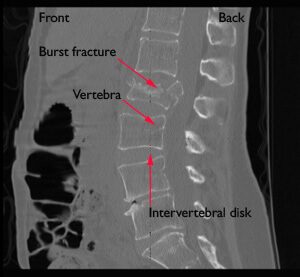
The treatment plan for a fracture of the thoracic or lumbar spine will depend on:
- Other injuries and their treatment
- The particular fracture pattern
Once the trauma team has stabilized all other life-threatening injuries, the doctor will evaluate the spinal fracture pattern and decide whether spine surgery is needed.
Flexion Fracture Pattern
Nonsurgical treatment. Most flexion injuries (compression fractures, burst fractures) can be treated in a brace for 6 to 12 weeks. By gradually increasing physical activity and doing rehabilitation exercises, most patients avoid post injury problems.
Surgical treatment. Surgery is typically required for unstable burst fractures that have:
- Significant comminution (fracture fragments)
- Severe loss of vertebral body height
- Excessive forward bending or angulation at the injury site
- Significant nerve injury due to parts of the vertebral body or disk pinching the spinal cord
These fractures should be treated surgically with decompression of the spinal canal and stabilization of the fracture. Decompression involves removing the bone or other structures that are pressing on the spinal cord. This procedure is also called a laminectomy.
To perform the decompression, your surgeon may decide to access your spine with an incision either on your side or on your back. Each approach allows for safe removal of the structures compressing the spinal cord while preventing further injury.
Extension Fracture Pattern
The treatment plan for extension injuries will depend on:
- Where the spine fails
- Whether the bones can be fit together again (reduction) using a brace or cast
Nonsurgical treatment. Extension fractures that occur only through the vertebral body can typically be treated nonsurgically. These should be observed closely in a brace or cast for 12 weeks.
Surgical treatment. Surgery is usually necessary if there is an injury to the posterior (back) ligaments of the spine. In addition, if the fracture falls through the disks of the spine, surgery should be performed to stabilize the fracture.
Rotation Fracture Pattern
Nonsurgical treatment. Transverse process fractures are predominantly treated with a gradual increase in motion, with or without bracing, based on comfort level.
Surgical treatment. Fracture-dislocations of the thoracic and lumbar spine are caused by very high-energy trauma. They can be extremely unstable injuries that often result in serious spinal cord or nerve damage. These injuries require stabilization through surgery. The ideal timing of these surgeries can often be complicated. Surgery is sometimes delayed because of other serious, life-threatening injuries.
Surgical Procedure
The ultimate goal for surgery is to achieve adequate reduction (fitting the bones together), relieve pressure on the spinal cord and nerves, and allow for early movement.
Depending on the fracture pattern, your surgeon may decide to do the procedure through an anterior (front), lateral (side), or posterior (back) approach, or a combination of all three.
Many types of instruments are used in surgery, including metal screws, rods, and cages to stabilize the spine.
An x-ray taken from the front shows metal screws and rods used to stabilize the spine after a burst fracture.
Complications
There are several complications associated with fractures of the thoracic and lumbar spine. One potentially fatal complication is blood clots in the legs, which may develop from immobility. These clots can travel to the lungs and cause death (pulmonary embolism). Pneumonia and pressure sores are also common complications of spinal fractures.
There are also specific surgical complications, including:
- Bleeding
- Infection
- Spinal fluid leaks
- Instrument failure
- Nonunion
Complications can be reduced by early treatment, mechanical methods (lower leg compression stockings), and medication to protect against clots, as well as proper surgical technique and postoperative programs.
Long-Term Outcomes
Regardless of whether the patient is treated with surgery, rehabilitation will be necessary after the injury has healed.
The goals of rehabilitation are to reduce pain, regain mobility, and return the patient to as close to preinjury state as possible. Both inpatient and outpatient physical therapy may be recommended to meet these goals.
Issues that may complicate these goals include inadequate reduction of the fracture, neurologic injury (paralysis), and progressive deformity.
